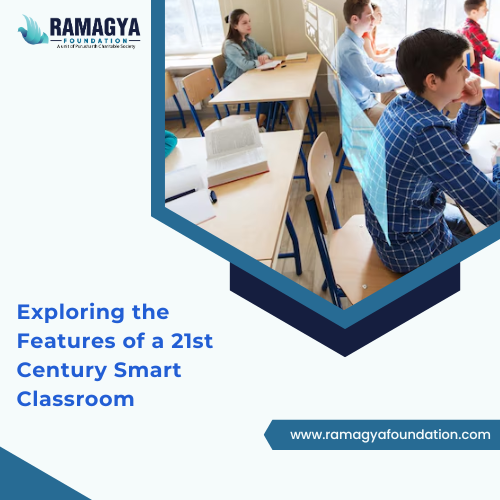
The 21st-century classroom has emerged as a dynamic and tech-savvy environment in the rapidly evolving education landscape, revolutionizing how students learn, and teachers instruct. At Ramagya Foundation, our commitment to providing quality education to the underprivileged extends to embracing the latest educational technologies and methods. Today, we’ll delve into the features of a 21st-century smart classroom, emphasizing the role of intelligent technology and innovative teaching practices.
Features of Smart Classroom
- Interactive Whiteboards
21st-century smart classrooms are equipped with interactive whiteboards, which serve as the modern-day replacement for traditional chalkboards. These digital displays enable teachers to project content from their devices, making lessons more engaging and interactive. According to the National Center for Education Statistics, 56% of K-12 schools in the United States use interactive whiteboards.
- Personal Devices and BYOD Policies
With the proliferation of smartphones, tablets, and laptops, personal devices have become invaluable tools for learning. Many 21st-century classrooms adopt Bring Your Device (BYOD) policies, allowing students to use their unique technology to access resources, collaborate, and complete assignments.
- Collaborative Learning Spaces
Collaboration is a cornerstone of the 21st-century smart classroom. Flexible furniture arrangements and designated collaborative areas encourage group work, discussions, and project-based learning. A report by Steelcase Education found that 80% of teachers believe collaborative learning spaces positively impact student engagement.
- Access to Digital Resources
The 21st-century classroom offers students access to a wealth of digital resources. E-books, online databases, and educational apps empower students to explore subjects in depth and at their own pace. The use of digital resources has been shown to increase student motivation and engagement, as per a study published in the Journal of Research in Education.
- Smartboards and Projectors
Smartboards and projectors are integral to modern classrooms, enhancing visual and interactive learning. These tools enable teachers to display multimedia content, annotate lessons, and interact with digital materials. A report by Futuresource Consulting predicts that the interactive display market in education will continue to grow.
- Flipped Classroom Model
The flipped classroom model, as endorsed by the Flipped Learning Network, reverses traditional teaching methods. Students access instructional content at home, typically video lectures, and engage in collaborative activities and discussions during class time. This approach promotes active learning and problem-solving.
- Adaptive Learning Systems
Adaptive learning systems, powered by artificial intelligence, personalize instruction to match each student’s learning pace and style. A report by Ambient Insight Research predicts that the adaptive learning market will continue to expand, helping educators tailor their lessons to individual needs.
- Virtual Reality (VR) and Augmented Reality (AR)
Virtual Reality (VR) and Augmented Reality (AR) transform students’ education experience. They provide immersive experiences that make complex concepts more understandable. Research from EdTech Magazine indicates that VR and AR applications in education are gaining traction.
- Online Learning Management Systems
Online Learning Management Systems (LMS) like Moodle and Canvas simplify administrative tasks, allow teachers to organize course materials, and offer a platform for student-teacher communication. LMS usage in higher education has grown significantly, as reported by eLearning Inside.
- Data-Driven Instruction
Data-driven instruction uses student performance data to inform teaching strategies. Teachers can identify areas where students need additional support and tailor their lessons accordingly. The use of data-driven instruction has shown positive effects on student achievement, as per a study by the Data Quality Campaign.
“In the 21st-century classroom, technology is not a supplement; it’s a necessity. It enables students to explore, engage, and excel like never before.” – Educational Innovator
Statistics on the 21st Century Classroom
- According to a report by EdSurge, 75% of teachers surveyed believe that technology has positively impacted education.
- The International Society for Technology in Education (ISTE) found that 89% of teachers consider technology essential.
- A New Media Consortium (NMC) Horizon Report study reveals that 86% of higher education institutions have adopted or are planning to adopt VR and AR in their classrooms.
“The future of education lies in the hands of innovative teachers who harness the power of technology to ignite students’ curiosity and creativity.”– Education Advocate
Conclusion
In conclusion, the features of a 21st-century classroom reflect a progressive shift in how education is delivered and experienced. Integrating smart technology, interactive learning tools, and innovative teaching practices creates an environment where students can explore, collaborate, and excel. At Ramagya Foundation, we are committed to bridging the digital divide and ensuring underprivileged students access the latest educational resources and methods.
By embracing the features of the 21st-century classroom, we aim to provide a transformative educational experience that empowers young learners for a bright and technologically advanced future.